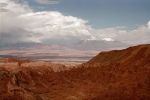 |
The Atacama covers most of the
northern part of Chile, and in reality continues
north up the coast of Perú for hundreds of miles. In
Chile it extends far into the mountains. Below about 3,000 meters, plant life
of any kind is usually limited to a few areas of oasis. I say usually, because when rare chubascos (thunderstorms)
drop rain in limited areas, long dormant seeds sprout
and the desert may be carpeted with flowers for a few
weeks. They soon disappear and may not be seen again for
a century. Another spot where plants may be scattered is
at the base of rocky coastal canyons where the incessant
morning fogs may condense enough to support a very few
burnt-looking little herbs. The desert rains may produce some
great rainbows, too, as I found when I was brushed by chubascos near San Pedro. |
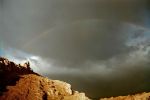 |
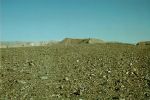 |
Most areas you see are vegetation-free,
however, quite a contrast to the temperate rain forests
of the southern parts of Chile, where plants may be
growing in such profusion that it's impossible to get
through them. A typical slope in
the Atacama might appear like a gravel pit or mine
tailings at first glance, though there is lots of variety
too. Sometimes soluble materials forming the bedrock are slowly eroded into fantastic
shapes by the rare rains - it must take eons! |
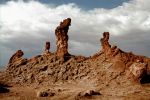 |
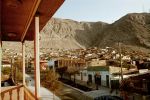 |
On the Atacama coast there are
scattered cities, depending on water piped dozens of
miles from streams that descend from the high mountains.
I visited several, and each was similar in that they end abruptly where the dusty, hot,
oddly humid urban area meets the stark desert barrier of
the coastal mountains. None of these coastal towns
looked hospitable to me, though several include large
glitzy resort areas where Chileans come north to play. In
the large city of Iquique, what the locals claim is the
world's tallest dune dwarfs the high-rises and condos of
the beach resort and appears to be swallowing parts of
the city. All through the
Atacama, there are wonderful sunsets! |
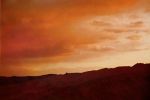 |
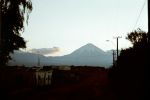 |
The village of San Pedro de la
Atacama was the best part of the visit to the Atacama
for me, as it is for many travelers. This is an old
mountain town, also called "El Oasis," at 2,500
meters near the Bolivian border. Though full of tourists,
it is worth a visit to see the stark, colorful landscapes
(reminiscent of Death Valley, CA), the high volcanoes (some over 6,000
meters), the quaint old adobe
town itself (including a 17th century church), and
the surprisingly good museum of archeology built by a
Belgian priest in the mid twentieth century. |
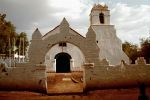 |
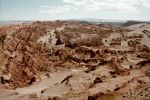 |
The San Pedro
area is extremely scenic, and one may choose from a
variety of tours, including a geyser field, salt lakes,
volcanoes, remote villages, several-day off-road caravans
to the Bolivian salar country, or trips to the desert
valleys nearer town. A popular half-day trip is to the
areas they call "Valle de
Muerte" (Death Valley) and Valle de la Luna (Moon Valley).
Some of my best photos of the trip, in my opinion, came
in these areas. The tour ended with a spectacular sunset viewed from
the top of a peak composed of good old table salt! |
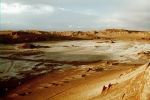 |
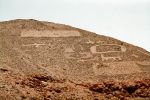 |
Another great sight in the desert was giant
geoglyphs - hundreds of pictures made on the actual
surface of the ground - at Pintados. These relics, probably thousands of
years old, are a national park and protected. You can't
get too close so they are hard to photograph, but the
light was pretty good when I was there and I think I got
some decent shots. Nearby are several mining ghost towns, including Humberstone, looking
almost as if you could move back in today, though it
has been abandoned over 50 years. |
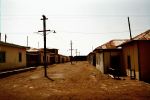 |
The rest of the trip? Well, wow!
It included many ruins (Tiwanaku and Isla del Sol in
Bolivia, numerous ruins in or near Cusco, Machu Picchu),
Lake Titicaca, the Urubamba River, a 4,660 meter pass,
interesting and odd foods such as alpaca steak and cuy (guinea
pig), and lots of other great experiences. I could go on
and on, but if you want to see those pictures feel
free check out this page with links to the rest of this trip as well
as other trips.Happy wandering! Tim Hilliard
September, 2010
|











